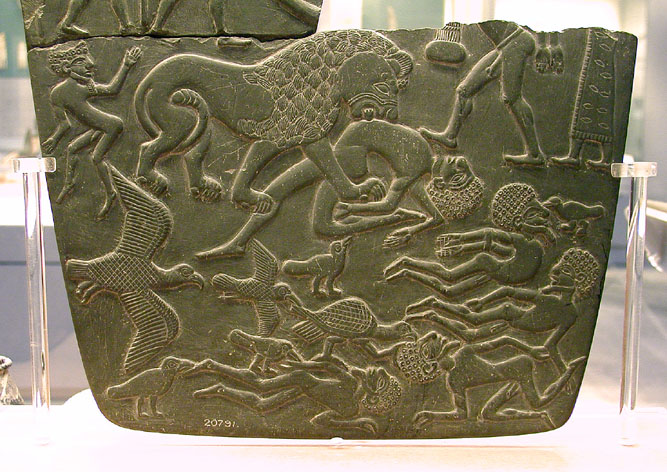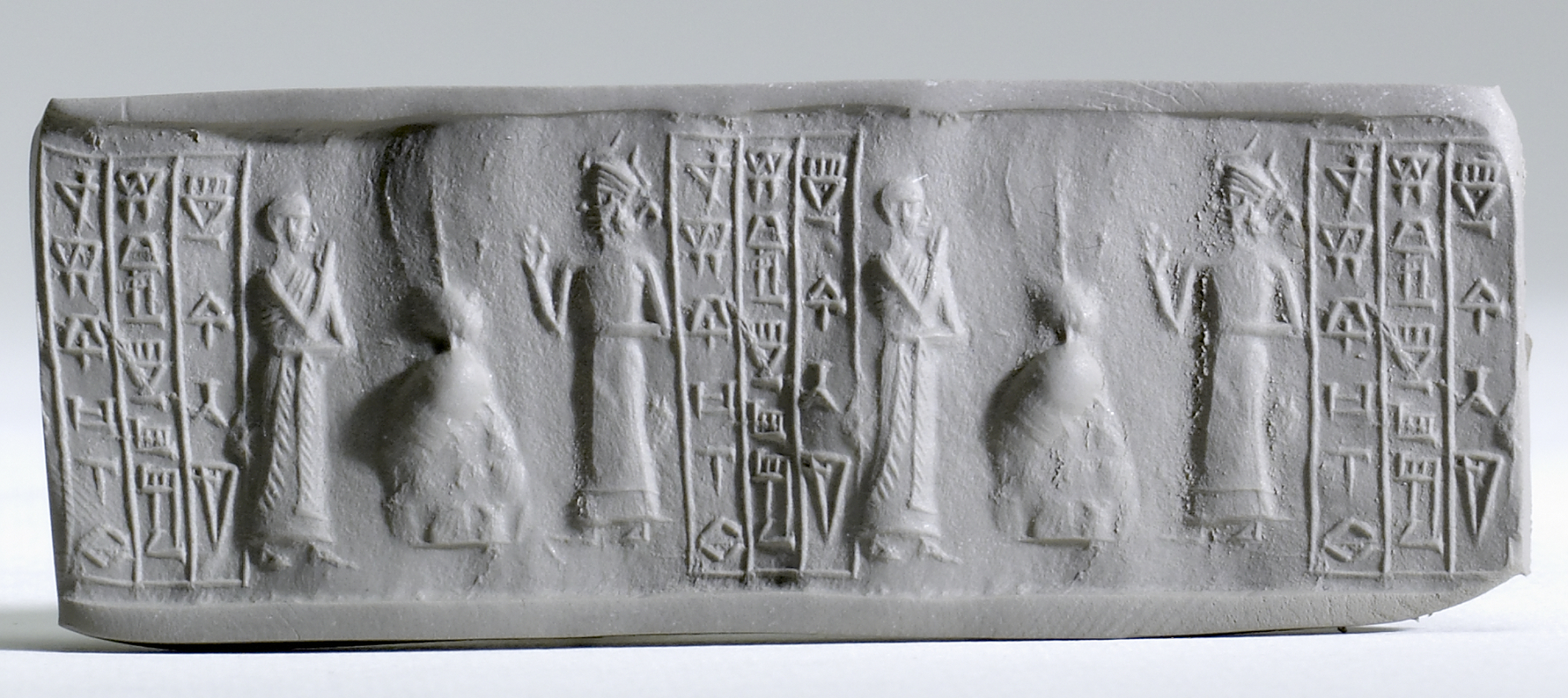|
Bull Palette
The Bull Palette ( French: palette célébrant une victoire) is the fragment of an Ancient Egyptian greywacke palette, carved in low relief and used, at least in principle, as a cosmetic palette for the grinding of cosmetics. It is dated to Naqada III, the final two centuries of the fourth millennium BC, immediately preceding the Early Dynastic Period). It is in the collection of the Louvre, inventory no. E11255. The palette is broken and only a portion of half of it remains. Both sides of it are carved, with some figures on each side differing from the other. The accompanying image presents both sides. The obverse of the cosmetic palette contains a large circular fortified city that is identified in its interior with a "larger-lion-and-'Nu'-(vessel)"– W24 a hieroglyph represented to the right of the lioness. The reverse of the cosmetic palette has iconography that became hieroglyphs for the: ''clenched fist'',Wilkinson, ''Reading Egyptian Art'', Clenched Hand, pp 54-55. ... [...More Info...] [...Related Items...] OR: [Wikipedia] [Google] [Baidu] |
Greywacke
Greywacke or graywacke (German ''grauwacke'', signifying a grey, earthy rock) is a variety of sandstone generally characterized by its hardness, dark color, and poorly sorted angular grains of quartz, feldspar, and small rock fragments or lithic fragments set in a compact, clay-fine matrix. It is a texturally immature sedimentary rock generally found in Paleozoic strata. The larger grains can be sand- to gravel-sized, and matrix materials generally constitute more than 15% of the rock by volume. The term "greywacke" can be confusing, since it can refer to either the immature (rock fragment) aspect of the rock or its fine-grained (clay) component. The origin of greywacke was unknown until turbidity currents and turbidites were understood, since, according to the normal laws of sedimentation, gravel, sand and mud should not be laid down together. Geologists now attribute its formation to submarine avalanches or strong turbidity currents. These actions churn sediment and cause mi ... [...More Info...] [...Related Items...] OR: [Wikipedia] [Google] [Baidu] |
Min (god)
Min (Egyptian mnw) is an ancient Egyptian god whose cult originated in the predynastic period (4th millennium BCE). He was represented in many different forms, but was most often represented in male human form, shown with an erect penis which he holds in his right hand and an upheld left arm holding a flail. Myths and function Min's cult began and was centered around Coptos (Koptos) and Akhmim (Panopolis) of upper Egypt, where in his honour great festivals were held celebrating his "coming forth" with a public procession and presentation of offerings. His other associations include the eastern desert and links to the god Horus. Flinders Petrie excavated two large statues of Min at Qift which are now in the Ashmolean Museum and it is thought by some that they are pre-dynastic. Although not mentioned by name, a reference to "he whose arm is raised in the East" in the Pyramid Texts is thought to refer to Min. His importance grew in the Middle Kingdom when he became even mo ... [...More Info...] [...Related Items...] OR: [Wikipedia] [Google] [Baidu] |
Gardiner's Sign List
Gardiner's Sign List is a list of common Egyptian hieroglyphs compiled by Sir Alan Gardiner. It is considered a standard reference in the study of ancient Egyptian hieroglyphs. Gardiner lists only the common forms of Egyptian hieroglyphs, but he includes extensive subcategories, and also both vertical and horizontal forms for many hieroglyphs. He includes size-variation forms to aid with the reading of hieroglyphs in running blocks of text. In contrast, for example, the Budge Reference has about 1,000 hieroglyphs listed in 50 pages, but with no size variations. Gardiner does not cross-index signs; once put on the list, other significant uses may be overlooked. One example of this is G16, nbtỉ, the ideogram for the Two Ladies, goddesses Wadjet as the cobra and Nekhbet as the white vulture. These are the protective and patron goddesses of the separate Egyptian kingdoms that joined into ancient Egypt, who were both then displayed on the uraeus of Wadjet when the unification ... [...More Info...] [...Related Items...] OR: [Wikipedia] [Google] [Baidu] |
Cosmetic Palette
Cosmetic palettes are archaeological Artifact (archaeology), artifacts, originally used in predynastic Egypt, predynastic ancient Egypt, Egypt to grind and apply ingredients for facial or body cosmetics. The decorative palettes of the late 4th millennium BC, 4th millennium BCE appear to have lost this function and became commemorative, ornamental, and possibly ceremonial. They were made almost exclusively out of siltstone with a few exceptions. The siltstone originated from quarries in the Wadi Hammamat. Many of the palettes were found at Hierakonpolis, a centre of power in Predynastic Egypt, pre-dynastic Upper Egypt. After the unification of the country, the palettes ceased to be included in tomb assemblages. Notable palettes Notable decorative palettes are: * The Cosmetic palette in the form of a Nile tortoise * The Narmer Palette, often thought to depict the unification of Upper and Lower Egypt under the pharaoh Narmer, Egyptian Museum, Cairo * Libyan Palette, Egyptian Museum, ... [...More Info...] [...Related Items...] OR: [Wikipedia] [Google] [Baidu] |
List Of Ancient Egyptian Palettes
A list of a small subset of ancient Egyptian palettes, ranging in the Naqada periods, 4th millennium BC, probably mostly from ~3500 to 3000 BC; some palettes may be from the later period of the earliest 3rd millennium BC. These cosmetic palettes come in numerous shapes and sizes, and were often found in tombs or graves. They were preceded by a period of palettes called rhomboidal palettes, unadorned, and without the ''cosmetic mixing circle'' found on some of the later Naqada period palettes. Alphabetical individual listing, (abbreviated) *Battlefield Palette *''"Two-bird headspalette (Brooklyn)"'' *"Bird palette (Louvre no XXX)"(bird-resting, on its feet) *Double-Bird Palette, (''"Anchor Palette"'') *Bull Palette *El Ahaiwah Dog Palette *Four Dogs Palette, Giraffes Palette * Oxford Palette''Minor Hierakonpolis Dogs Palette'' *"Fish palette (Louvre dolphin type)" *New Kingdom: Fish-shaped palette-(Bulti-hieroglyph type); Adorned fish side/ with cosmetic side for daily use. ... [...More Info...] [...Related Items...] OR: [Wikipedia] [Google] [Baidu] |
Narmer Palette
The Narmer Palette, also known as the Great Hierakonpolis Palette or the Palette of Narmer, is a significant Egyptian archeological find, dating from about the 31st century BC, belonging, at least nominally, to the category of cosmetic palettes. It contains some of the earliest Egyptian hieroglyphs, hieroglyphic inscriptions ever found. The tablet is thought by some to depict the unification of Upper Egypt, Upper and Lower Egypt under the king Narmer. Along with the Scorpion Macehead and the Narmer Maceheads, also found together in the main deposit at Nekhen, the Narmer Palette provides one of the earliest known depictions of an Egyptian king. On one side, the king is depicted with the bulbed Hedjet, White Crown of Upper (southern) Egypt, and the other side depicts the king wearing the level Deshret, Red Crown of Lower (northern) Egypt, which also makes it the earliest known example of a king wearing both types of headdress. The Palette shows many of the classic conventions of Anci ... [...More Info...] [...Related Items...] OR: [Wikipedia] [Google] [Baidu] |
Hairdo
A hairstyle, hairdo, haircut or coiffure refers to the styling of hair, usually on the human scalp. Sometimes, this could also mean an editing of facial or body hair. The fashioning of hair can be considered an aspect of personal grooming, fashion, and cosmetics, although practical, cultural, and popular considerations also influence some hairstyles. The oldest known depiction of hair styling is hair braiding which dates back about 30,000 years. In history, women's hair was often elaborately and carefully dressed in special ways, though it was also often kept covered outside the home, especially for married women. From the time of the Roman Empire until the Middle Ages, most women grew their hair as long as it would naturally grow. Between the late 15th century and the 16th century, a very high hairline on the forehead was considered attractive. Around the same period, European men often wore their hair cropped no longer than shoulder-length. In the early 17th century, ma ... [...More Info...] [...Related Items...] OR: [Wikipedia] [Google] [Baidu] |
Bas Relief
Relief is a sculptural method in which the sculpted pieces are bonded to a solid background of the same material. The term ''relief'' is from the Latin verb ''relevo'', to raise. To create a sculpture in relief is to give the impression that the sculpted material has been raised above the background plane. When a relief is carved into a flat surface of stone (relief sculpture) or wood (relief carving), the field is actually lowered, leaving the unsculpted areas seeming higher. The approach requires a lot of chiselling away of the background, which takes a long time. On the other hand, a relief saves forming the rear of a subject, and is less fragile and more securely fixed than a sculpture in the round, especially one of a standing figure where the ankles are a potential weak point, particularly in stone. In other materials such as metal, clay, plaster stucco, ceramics or papier-mâché the form can be simply added to or raised up from the background. Monumental bronze reliefs a ... [...More Info...] [...Related Items...] OR: [Wikipedia] [Google] [Baidu] |
Register (sculpture)
In art and archaeology, in sculpture as well as in painting, a register is a horizontal level in a work that consists of several levels arranged one above the other, especially where the levels are clearly separated by lines. Modern comic books typically use similar conventions. It is thus comparable to a row, or a line in modern texts. In the study of ancient writing, such as cuneiform and Egyptian hieroglyphs, "register" may be used of vertical compartments like columns containing writing that are arranged side by side and separated by lines, especially in cylinder seals, which often mix text and images. Normally, when dealing with images it only refers to row compartments stacked vertically. Among many other cultures, the use of registers is common in Ancient Egyptian art, from the Narmer Palette onwards, and in medieval art in large frescos and illuminated manuscripts. Narrative art, especially covering the lives of sacred figures, is often presented as a sequence of smal ... [...More Info...] [...Related Items...] OR: [Wikipedia] [Google] [Baidu] |
Schist
Schist ( ) is a medium-grained metamorphic rock showing pronounced schistosity. This means that the rock is composed of mineral grains easily seen with a low-power hand lens, oriented in such a way that the rock is easily split into thin flakes or plates. This texture (geology), texture reflects a high content of platy minerals, such as micas, talc, chlorite group, chlorite, or graphite. These are often interleaved with more granular minerals, such as feldspar or quartz. Schist typically forms during regional metamorphism accompanying the process of mountain building (orogeny) and usually reflects a medium Metamorphism#Metamorphic grades, grade of metamorphism. Schist can form from many different kinds of rocks, including sedimentary rocks such as mudstones and igneous rocks such as tuffs. Schist metamorphosed from mudstone is particularly common and is often very rich in mica (a ''mica schist''). Where the type of the original rock (the protolith) is discernible, the schist is us ... [...More Info...] [...Related Items...] OR: [Wikipedia] [Google] [Baidu] |








